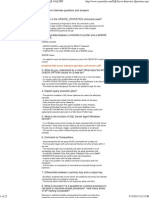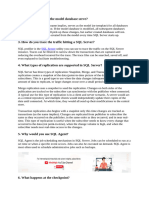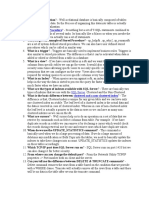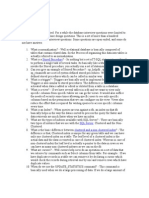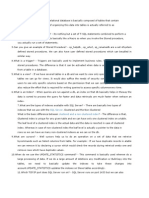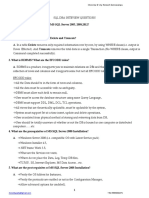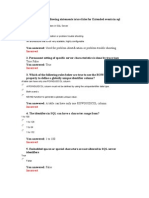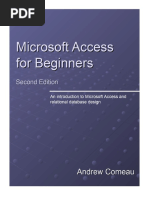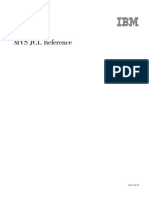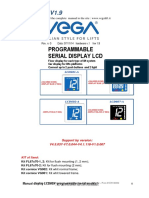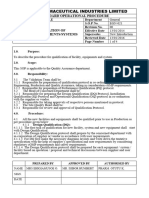0 ratings0% found this document useful (0 votes)
38 viewsSQL Server Interview Questions
The document lists the top 10 interview questions that SQL Server developers should prepare for. The questions cover topics such as dynamic management views, temp tables, indexes, transactions, database consistency checker commands, query execution plans, and default SQL Server ports. Understanding the answers to these common questions is important for demonstrating competence in SQL Server development to potential employers.
Uploaded by
BommannanCopyright
© © All Rights Reserved
Available Formats
Download as DOCX, PDF, TXT or read online on Scribd
0 ratings0% found this document useful (0 votes)
38 viewsSQL Server Interview Questions
The document lists the top 10 interview questions that SQL Server developers should prepare for. The questions cover topics such as dynamic management views, temp tables, indexes, transactions, database consistency checker commands, query execution plans, and default SQL Server ports. Understanding the answers to these common questions is important for demonstrating competence in SQL Server development to potential employers.
Uploaded by
BommannanCopyright
© © All Rights Reserved
Available Formats
Download as DOCX, PDF, TXT or read online on Scribd
You are on page 1/ 3
SQL Server Interview Questions: 10 Questions You Should Be Prepared For Interview
It’s no secret that SQL Server Developer jobs are in high demand. In
fact, according to a recent study database careers represent some of the
most stable careers in tech. If you’ve been pursuing a career in SQL Server
development, and you made it to the first interview, congratulations! But
now you actually have to make it through the first interview in the hiring
process.
What kinds of questions will the
interviewer ask?
It’s important to understand the nature of the questions you’ll be asked.
Odds are the interviewer isn’t going to be asking you many soft-ball
questions. If they’re going to trust you with developing their massive SQL
Server database then they need to know you’re not just competent, but that
you know what you’re talking about.
Top 10 Interview Questions for SQL
Server Developers
1. What are DMVs? - Dynamic Management Views (DMVs), are
functions that give you information on the state of the server.
DMVs, for the most part, are used to monitor the health of a
server. They really just give you a snapshot of what’s going on
inside the server. They let you monitor the health of a server
instance, troubleshoot major problems and tune the server to
increase performance.
2. Define a temp table - In a nutshell, a temp table is a
temporary storage structure. What does that mean? Basically,
you can use a temp table to store data temporarily so you can
manipulate and change it before it reaches its destination
format.
3. What’s the difference between a local temp table and a
global temp table? - Local tables are accessible to a current
user connected to the server. These tables disappear once the
user has disconnected from the server. Global temp tables, on
the other hand, are available to all users regardless of the
connection. These tables stay active until all the global
connections are closed.
4. How do you use transactions? - In general, there are three
types of transactions that you can use in the SQL Server
environment: BEGIN TRANSACTION, ROLL BACK TRANSACTION
and COMMIT TRANSACTION. The gist behind deploying
transactions is that they allow you to group multiple SQL
commands into a single unit. From there, each transaction
begins with a certain task, and ends when all the tasks within
the transaction are complete. BEGIN TRANSACTION gets the
ball rolling. ROLLBACK TRANSACTION functions a lot like an
“undo” command, and COMMIT TRANSACTION completes all of
the tasks within that transaction.
5. What’s the difference between a clustered and a non-
clustered index? - A clustered index directly affects the way
tabled data is stored on a specific disk. This means that when a
clustered index is used, data is stored in sequential rows based
on the index column value. This is why a table can only contain
a single clustered index. Non-clustered indexes directly affect
the way physical data is stored and managed within SQL Server.
6. What are DBCC commands? - In very basic terms the Database
Consistency Checker (DBCC) is used to aid in server
maintenance. DBCC commands, many of which are completely
undocumented, provide a set of commands that let you
perform routing maintenance, status and validation checks. The
most common DBCC commands are: DBCC CHECKALLOC (Lets
you check disk allocation); DBCC OPENTRAN (Lets you check
any open transactions); and DBCC HELP (shows a list of
available DBCC commands to aid your server maintenance
processes).
7. Describe the difference between truncate and delete - The
difference between these two processes is fairly simple.
Truncate means to simply empty out a table. On the other
hand, the delete command lets you delete entire rows from
within a table, but not all of the data within that table.
8. What is a view? - A view is simply a virtual table that is made
up of elements of multiple physical or “real” tables. Views are
most commonly used to join multiple tables together, or control
access to any tables existing in background server processes.
9. What is a Query Execution Plan? - SQL Server has several
built-in tools that optimize how queries are executed within
their databases. A query execution plan is exactly what it
sounds like – a snapshot of how the optimizing tools will
execute and deploy specific queries within the database. This
service helps you troubleshoot problems with jobs that don’t
necessarily execute perfectly.
10. What is the default port number for SQL Server? - While
this is kind of a softball question – if you know anything about
SQL Server you should at least know the basic configuration
options – it’s an important one to nail in the interview. Basically,
when SQL Server is enabled the server instant listens to the TCP
port 1433.
**Learn SQL Server database with this online, on-demand course from
Udemy**
You might also like
- Dangerous Google - Searching For Secrets PDF88% (26)Dangerous Google - Searching For Secrets PDF12 pages
- Download ebooks file The Volatility Edge in Options Trading New Technical Strategies for Investing in Unstable Markets 1st Edition Jeff Augen all chaptersNo ratings yetDownload ebooks file The Volatility Edge in Options Trading New Technical Strategies for Investing in Unstable Markets 1st Edition Jeff Augen all chapters55 pages
- David Amos, Dan Bader, Joanna Jablonski, Fletcher Heisler Python100% (15)David Amos, Dan Bader, Joanna Jablonski, Fletcher Heisler Python643 pages
- Understanding Database Types - by Alex XuNo ratings yetUnderstanding Database Types - by Alex Xu13 pages
- Policy Document Ucc Redemption Understanding The Process Further80% (20)Policy Document Ucc Redemption Understanding The Process Further37 pages
- 500 SQL Server Interview Questions and Answers - SQL FAQ PDF75% (12)500 SQL Server Interview Questions and Answers - SQL FAQ PDF22 pages
- Dark Web Market Price Index Hacking Tools July 2018 Top10VPN291% (11)Dark Web Market Price Index Hacking Tools July 2018 Top10VPN27 pages
- Allison, Berkowitz - 2008 - SQL For Microsoft Access PDF100% (1)Allison, Berkowitz - 2008 - SQL For Microsoft Access PDF393 pages
- What Purpose Does The Model Database Serve?: SQL ServerNo ratings yetWhat Purpose Does The Model Database Serve?: SQL Server10 pages
- SQL Server Interview Questions and Answers PDFNo ratings yetSQL Server Interview Questions and Answers PDF22 pages
- SQL Interview Questions: Ans: 8060 Bytes Allowed Per A Single Row in A TableNo ratings yetSQL Interview Questions: Ans: 8060 Bytes Allowed Per A Single Row in A Table3 pages
- Pawan Kumar Khowal SQL Server Interview Questions Only Set 1 100 QuestionsNo ratings yetPawan Kumar Khowal SQL Server Interview Questions Only Set 1 100 Questions3 pages
- Foreign Keys Prevents Any Actions That Would Destroy Links Between Tables With100% (1)Foreign Keys Prevents Any Actions That Would Destroy Links Between Tables With22 pages
- SQL Server Interview Questions and Answers PDF - Freshers and Experienced Interview Questions PDF0% (3)SQL Server Interview Questions and Answers PDF - Freshers and Experienced Interview Questions PDF16 pages
- 15 Conceptual SQL Interview Questions and Answers - by John H. - MediumNo ratings yet15 Conceptual SQL Interview Questions and Answers - by John H. - Medium9 pages
- SQL Server DBA Interview Questions and Answers: AnswerNo ratings yetSQL Server DBA Interview Questions and Answers: Answer13 pages
- SQL Server Interview Questions and Answers For FreshersNo ratings yetSQL Server Interview Questions and Answers For Freshers9 pages
- SQL Server Developer Interview QuestionNo ratings yetSQL Server Developer Interview Question11 pages
- SQL Server Interview Questions and AnswersNo ratings yetSQL Server Interview Questions and Answers2 pages
- Baker Construction....................... SQL ScreeningNo ratings yetBaker Construction....................... SQL Screening8 pages
- 80 Top SQL Interview Questions and Answers (2024) - DataCampNo ratings yet80 Top SQL Interview Questions and Answers (2024) - DataCamp25 pages
- SQL Server and ASP Net Questions & AnswersNo ratings yetSQL Server and ASP Net Questions & Answers12 pages
- Sql : The Ultimate Beginner to Advanced Guide To Master SQL Quickly with Step-by-Step Practical ExamplesFrom EverandSql : The Ultimate Beginner to Advanced Guide To Master SQL Quickly with Step-by-Step Practical ExamplesNo ratings yet
- Full download Network Security and Cryptography Sarhan M. Musa pdf docxNo ratings yetFull download Network Security and Cryptography Sarhan M. Musa pdf docx40 pages
- SFDSFD401 - Basics and Fundamentals of DatabaseNo ratings yetSFDSFD401 - Basics and Fundamentals of Database77 pages
- Time Leisure and Well Being 1st Edition Jiri Zuzanek pdf download100% (1)Time Leisure and Well Being 1st Edition Jiri Zuzanek pdf download58 pages
- Studies On Preparation of Custard Apple VinegarNo ratings yetStudies On Preparation of Custard Apple Vinegar6 pages
- 2013 IB Economics Internal Assessment CRITERIANo ratings yet2013 IB Economics Internal Assessment CRITERIA1 page
- 6093d9371fcc533e30f3b6cd - FRD FXJ SERIESNo ratings yet6093d9371fcc533e30f3b6cd - FRD FXJ SERIES4 pages
- Chem Grade 9 Answer Key of End Chapter QuestionsNo ratings yetChem Grade 9 Answer Key of End Chapter Questions3 pages
- A Study On SHG-Bank Linkage and Status of MFI in BiharNo ratings yetA Study On SHG-Bank Linkage and Status of MFI in Bihar196 pages
- Electrical Chelopara Uposhakha, Bogura-Model PDFNo ratings yetElectrical Chelopara Uposhakha, Bogura-Model PDF1 page
- Qualification of Facility, Equipments, Systems100% (1)Qualification of Facility, Equipments, Systems4 pages
- Law, Economics and Start Up Project ProjectNo ratings yetLaw, Economics and Start Up Project Project25 pages












